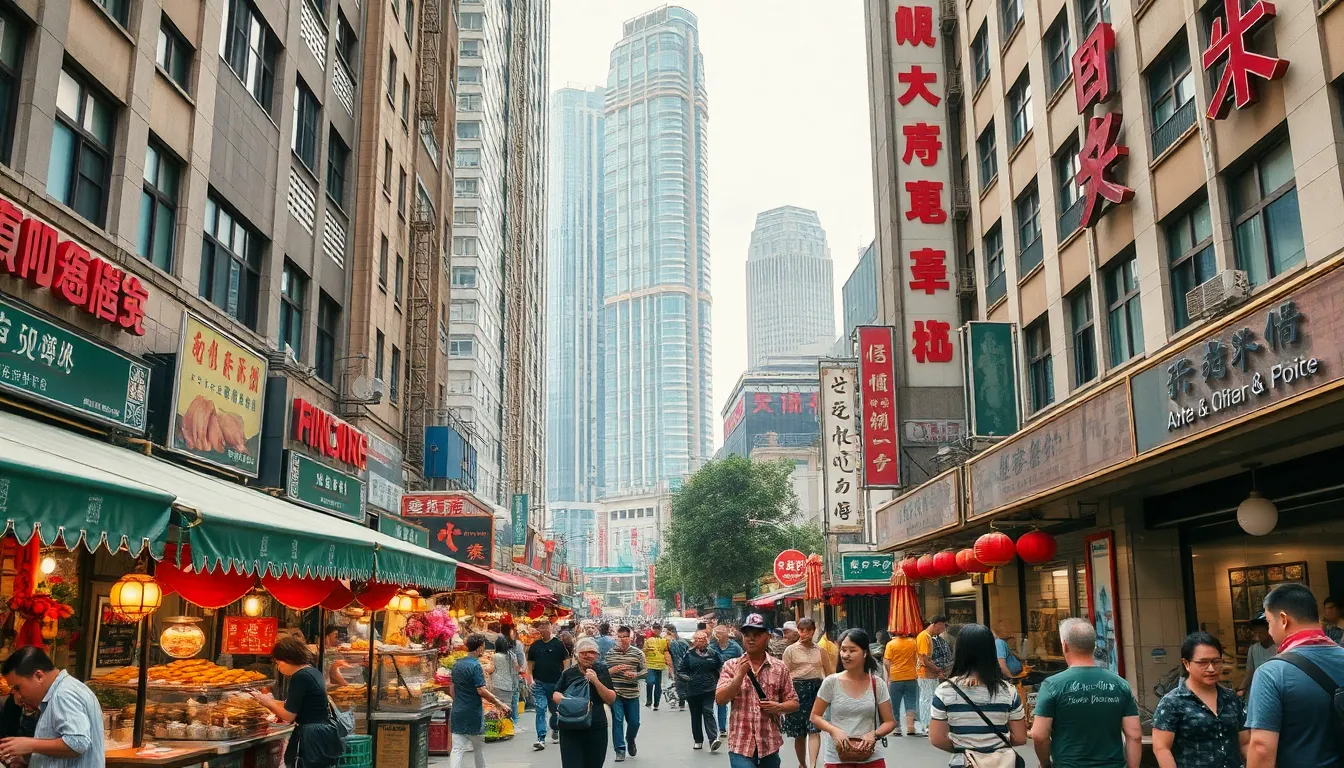In a world where cities stretch endlessly and cultures collide, the term “Chinese megalopolis” sparks curiosity and excitement. Imagine a place so vast it could make New York City look like a cozy neighborhood. These urban giants are not just about size; they’re vibrant hubs of innovation, tradition, and, let’s be honest, some of the best street food you’ll ever taste.
Table of Contents
ToggleOverview of Chinese Megalopolises
Chinese megalopolises represent expansive urban areas that showcase a blend of innovation and rich culture. These vibrant centers foster remarkable economic activity and social engagement.
Definition of Megalopolis
A megalopolis refers to a highly populated urban area that encompasses multiple large cities or towns. This term often applies to regions where urban centers merge, creating a continuous metropolitan landscape. In China’s context, megalopolises serve as critical economic, cultural, and political hubs, influencing both domestic and international developments.
Key Characteristics
Key characteristics define Chinese megalopolises. They exhibit significant population density, with millions of residents living within close proximity. Economic diversity thrives, allowing for a mix of industries such as technology, manufacturing, and services. Infrastructure stands out, featuring advanced transportation networks that facilitate movement. Cultural richness adds depth, blending traditional customs with modern influences. These urban areas also experience rapid growth and frequent urbanization, reflecting shifts in demographic trends and economic policies.
Notable Chinese Megalopolises

Chinese megalopolises serve as pivotal urban centers, showcasing remarkable diversity and cultural richness.
Beijing
Beijing stands as the capital city of China and is known for its historic significance. With a population exceeding 21 million residents, it acts as a powerhouse for political and cultural activities. This megalopolis features iconic landmarks like the Great Wall and the Forbidden City, attracting millions of tourists each year. In addition to its historical sites, Beijing offers a vibrant modern infrastructure that includes state-of-the-art transport systems. Educational institutions, such as Peking University, contribute significantly to its status as a center of learning.
Shanghai
Shanghai ranks as one of the largest cities in the world, characterized by its stunning skyline and rapid economic growth. Home to over 24 million residents, it serves as a critical financial hub in Asia. The city’s bustling port facilitates international trade, making it a key player in global markets. Shanghai hosts attractions like the Bund, which showcases colonial architecture and views of the Huangpu River. Advanced public transport systems, such as the Maglev train, optimize commuting across this sprawling metropolis.
Guangzhou
Guangzhou is notable for its rich history and economic significance, boasting a population of approximately 15 million. Situated in southern China, it serves as a central trading city thanks to its strategic location along the Pearl River. This megalopolis embraces cultural diversity, reflected in its cuisine and festivals. Cantonese food, renowned worldwide, originates from this region, highlighting local culinary traditions. Furthermore, the annual Canton Fair promotes international business, underpinning Guangzhou’s role in global commerce.
Impact of Urbanization
Urbanization significantly shapes the landscapes and experiences within Chinese megalopolises. The rapid influx of people into these areas affects various facets of life.
Economic Development
Economic development flourishes in Chinese megalopolises. They generate substantial GDP contributions, with each city playing a vital role in national economic growth. Shanghai leads as a global financial center, while Beijing excels in technology and innovation sectors. Additionally, Guangzhou promotes trade and tourism, bolstering its local economy. Multi-industry diversification creates job opportunities, attracting skilled labor from across the nation. Continued urbanization fosters new business ventures, highlighting the importance of these metropolises in the larger economic ecosystem.
Social Changes
Social changes arise from the dynamic environment in Chinese megalopolises. Population growth drives cultural exchange and influences social norms. Increased diversity leads to a blend of lifestyles, where traditional practices coexist with modern trends. Educational opportunities expand as access to schools and universities improves, empowering the younger generation. Urbanization also enhances public services, including transportation and healthcare, addressing the needs of expanding populations. Overall, the vibrant social scene in these cities promotes community engagement and collective identity among residents.
Cultural Significance
Chinese megalopolises play a crucial role in shaping the nation’s cultural landscape. These urban centers merge history with contemporary life, reflecting a rich tapestry of traditions and innovations.
Historical Context
Historical significance defines many aspects of Chinese megalopolises. Cities like Beijing host ancient architecture that narrates tales of past dynasties, making them cultural treasures. Events and movements throughout history have influenced local customs, shaping the identity of these urban areas. Shanghai’s emergence as a major port city symbolizes the transformation of trade and commerce in modern China. Guangzhou, with its history as a key trading hub, showcases the remnants of ancient trade routes. The blend of historical landmarks and modern developments creates a unique character in these megalopolises, attracting scholars and tourists alike.
Modern Influence
Modern megalopolises wield significant influence on global culture. They are hotbeds for artistic expression, featuring emerging artists and innovative cultural festivals. Vibrant street life, coupled with modern technological advancements, fosters an environment ripe for creativity. Additionally, these cities function as economic engines, attracting international businesses and fostering cross-cultural exchanges. Increased globalization exposes residents to diverse lifestyles and ideas, enhancing cultural fusion. Traditional practices coexist alongside contemporary trends, exemplifying how modern influences shape social norms and daily life. Each megalopolis serves as a microcosm of broader societal changes occurring both in China and globally.
Environmental Challenges
Chinese megalopolises face significant environmental challenges, primarily stemming from rapid urbanization and industrialization.
Pollution Issues
Air quality suffers due to emissions from factories and vehicles. High levels of particulate matter contribute to health problems among residents. Water pollution also poses threats, with industrial runoff contaminating rivers and lakes. Heavy traffic exacerbates noise pollution, affecting quality of life. According to the World Health Organization, cities like Beijing experience air pollution levels that exceed safe limits. Urgent measures are necessary to address these pollution issues and ensure a healthier environment for urban populations.
Urban Planning Solutions
Effective urban planning strategies offer pathways to mitigate environmental challenges. Implementation of green spaces within cities enhances air quality and supports biodiversity. Smart public transportation systems reduce reliance on personal vehicles, addressing traffic congestion and emissions. Zoning regulations that promote sustainable construction practices foster environmentally friendly development. Investment in renewable energy sources, such as solar and wind, can significantly lower carbon footprints. Adopting these solutions encourages a shift towards sustainable living in Chinese megalopolises.
Chinese megalopolises stand as remarkable examples of urban evolution blending history with modernity. They not only drive economic growth but also serve as cultural epicenters that reflect the nation’s diverse heritage. As these cities continue to expand and adapt to the challenges of urbanization, their influence on global culture and economy is undeniable.
Addressing environmental concerns through innovative urban planning will be crucial for their sustainability. The future of these megalopolises hinges on balancing growth with ecological responsibility, ensuring they remain vibrant and livable for generations to come. The journey of these urban giants is just beginning, and their stories are set to shape the narrative of urbanization worldwide.





